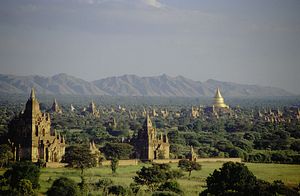MANDALAY – Restoring ancient temples has its own politics. The Indians found this out through their restoration work at Angkor Wat in northwest Cambodia, which they initiated in the 1980s, motivated primarily by the shared Hindu culture of the two countries.
The Indians had hoped to improve on earlier work undertaken by the French colonialists. But New Delhi’s good intentions did not stop critics who argued the Indians had rushed their work and damaged the stone surfaces with their choice of chemicals and cement.
It’s an issue that is now confronting the authorities in Bagan, Myanmar, where more than 10,000 religious monuments and temples were constructed around the same time as Angkor was hitting its peak in the 11th and 12th centuries.
Construction here began under King Anawratha, the monarch who unified the country, and in those days artisans would have their hands or feet chopped off if their work was deemed not up to scratch.
Late last month, Myanmar was hit by a 6.8 magnitude earthquake. It claimed three lives and scared many witless. In Bagan, more than 180 ancient temples were badly damaged. Authorities were quick to respond and recently, even the country’s de facto leader Aung San Suu Kyi stepped in.
Restoration work on the remaining 2,000-odd temples covering 80 square kilometers at Bagan, like that at Angkor, has already been sharply criticized.
The Burmese military, which ran the country for half century, was not the brightest government in the region and its attitudes toward international standards were as arrogant as they were ill-informed.
Initial restoration work began on 600 pagodas in 1975 following an earthquake, but that work was roundly criticized as poor. Undeterred efforts were stepped up after the pro-democracy movement was crushed in 1988, with much of the attempted restoration work done in the 1990s to bolster national pride.
Their crude attempts at restoring the temples were highlighted by the earthquake, which revealed shoddy, hasty workmanship and repairs carried out with cement and not in accordance with proper scientific methodology. Tremors caused bricks to tumble. The spires in the pagodas cracked and shifted as did the mortar, proving incapable of supporting the ancient ceilings under such stress.
Centuries of decay and neglect coupled with shoddy work and the shunning of the Burmese junta by the international community meant that the temples at Bagan, once home to 200,000 people, were never considered by UNESCO for a World Heritage listing.
Suu Kyi has told the Culture and Religious Affairs Ministry to refrain from conducting urgent renovations. Sun Oo, President of the Association of Myanmar Architects, stepped in to say that repair works had to be done carefully and without rush.
“The world heritage renovation principles should be followed,” he said.
“First, we must collect data about the damaged pagodas and after we have documented the situation on the ground, we can repair the high-priority pagodas,” he told the Myanmar Times. “We do not want to reduce the value of our heritage sites again due to bad renovation.”
Funding for the temples has changed, which should lead to a proper reconstruction effort. Since January, six percent of entrance fees have been earmarked for the establishment of a Bagan conservation zone through the Myanmar Tourism Federation (MTF).
Still, this has been criticized as too little.
“The previous leaders reconstructed as they liked,” Sun Oo said.
“Bagan is not only for Myanmar heritage but also for world heritage. That is why they should really work with the experts while renovating.”
If the MTF can get it right, then Bagan – a significant Southeast Asia archeological landmark by any measure – should join Angkor Wat and Indonesia’s Borobudur temple as a World Heritage Site.
Luke Hunt can be followed on Twitter @lukeanthonyhunt

































